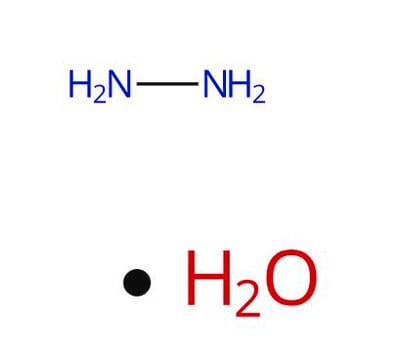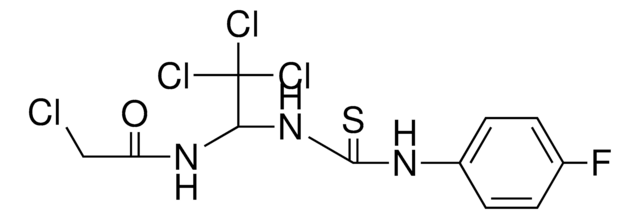If this product has an expiration or retest date, it will be shown on the Certificate of Analysis (COA, CofA). If there is no retest or expiration date listed on the product's COA, we do not have suitable stability data to determine a shelf life. For these products, the only date on the COA will be the release date; a retest, expiration, or use-by-date will not be displayed.
For all products, we recommend handling per defined conditions as printed in our product literature and website product descriptions. We recommend that products should be routinely inspected by customers to ensure they perform as expected.
For products without retest or expiration dates, our standard warranty of 1 year from the date of shipment is applicable.
For more information, please refer to the Product Dating Information document: https://www.sigmaaldrich.com/deepweb/assets/sigmaaldrich/marketing/global/documents/449/386/product-dating-information-mk.pdf
225819
Hydrazine hydrate
reagent grade, N2H4 50-60 %
Synonym(s):
Hydrazinium hydroxide
Select a Size
About This Item
Recommended Products
grade
reagent grade
Quality Level
vapor density
>1 (vs air)
vapor pressure
5 mmHg ( 25 °C)
form
liquid
composition
Degree of hydration, ~1.5
N2H4, 50-60%
expl. lim.
99.99 %
concentration
50.0-60.0% (%H4N2 by Na2S2O3 basis, titration)
density
1.029 g/mL at 25 °C (lit.)
SMILES string
NN.[H]O[H]
InChI
1S/H4N2.H2O/c1-2;/h1-2H2;1H2
InChI key
IKDUDTNKRLTJSI-UHFFFAOYSA-N
General description
Application
- 3-(2-Benzyloxy-6-hydroxyphenyl)-5-styrylpyrazoles by reacting with 5-benzyloxy-2-styrylchromones.[7]
- 3,5-Diphenyl-2-pyrazoline derivatives by reacting with 1,3-diphenyl-2-propen-1-one.[8]
- 3′-Aryl-1,2,3,4,4′,5′-hexahydrospiro[quinoxalin-2,5′-pyrazol]-3-ones by reacting with 3-arylacylidene-3,4-dihydroquinoxalin-2(1H)-ones.[9]
- It may also be used in the catalytic reduction of nitroarenes to aromatic amines.[10]
related product
signalword
Danger
Hazard Classifications
Acute Tox. 2 Inhalation - Acute Tox. 3 Dermal - Acute Tox. 3 Oral - Aquatic Acute 1 - Aquatic Chronic 1 - Carc. 1B - Eye Dam. 1 - Flam. Liq. 3 - Skin Corr. 1B - Skin Sens. 1
Storage Class
3 - Flammable liquids
wgk_germany
WGK 3
flash_point_f
204.8 °F - closed cup
flash_point_c
96 °C - closed cup
ppe
Faceshields, Gloves, Goggles, type ABEK (EN14387) respirator filter
Choose from one of the most recent versions:
Already Own This Product?
Find documentation for the products that you have recently purchased in the Document Library.
Customers Also Viewed
Articles
Professor Aran discusses engineering graphene-based materials through careful functionalization, enabling diverse applications.
-
How can I determine the shelf life / expiration / retest date of this product?
1 answer-
Helpful?
-
-
How is shipping temperature determined? And how is it related to the product storage temperature?
1 answer-
Products may be shipped at a different temperature than the recommended long-term storage temperature. If the product quality is sensitive to short-term exposure to conditions other than the recommended long-term storage, it will be shipped on wet or dry-ice. If the product quality is NOT affected by short-term exposure to conditions other than the recommended long-term storage, it will be shipped at ambient temperature. As shipping routes are configured for minimum transit times, shipping at ambient temperature helps control shipping costs for our customers. For more information, please refer to the Storage and Transport Conditions document: https://www.sigmaaldrich.com/deepweb/assets/sigmaaldrich/marketing/global/documents/316/622/storage-transport-conditions-mk.pdf
Helpful?
-
-
What is the Department of Transportation shipping information for this product?
1 answer-
Transportation information can be found in Section 14 of the product's (M)SDS.To access the shipping information for this material, use the link on the product detail page for the product.
Helpful?
-
-
Is Product 225819, Hydrazine hydrate, a liquid or a solid?
1 answer-
The package sizes for this product are in a mass unit (gram) rather than a volume unit (mL). However, this product is a liquid and not a solid. It has a reported density of 1.029 g/mL at 25°C.
Helpful?
-
-
What is the difference between Hydrazine hydrate product numbers 225819, 215155 and 207942?
1 answer-
Prod. No. 215155 is anhydrous hydrazine. There is no water associated with this product. It has a molecular (formula) weight of 32.05. Prod. No. 207942 is hydrazine monohydrate. There is one mole of water for every mole of hydrazine. It has a molecular (formula) weight of 50.06. Prod. No. 225819 is hydrazine hydrate. The hydrazine content by weight from batch to batch may vary between 50 to 60%. Because the amount of water present (the other 40 to 50%) will also vary from batch to batch, it does not have a defined molecular (formula) weight. If a batch was found to contain 54 wt% hydrazine, then that batch would have 1.5 moles of water for every mole of hydrazine.
Helpful?
-
Active Filters
Our team of scientists has experience in all areas of research including Life Science, Material Science, Chemical Synthesis, Chromatography, Analytical and many others.
Contact Technical Service












